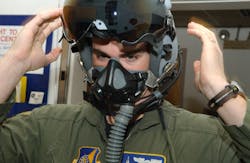Army asks industry for prototype helmet visors that adjust automatically from darkness to full sunlight
ORLANDO, Fla. – U.S. Army researchers are asking industry to develop prototype electrochromic auto-tinting goggles, glasses, and helmet visors that adjust automatically from near total darkness to full sunlight that improve existing military visual display systems.
Officials of the Army Contracting Command in Orlando, Fla., issued a request for solutions (W900KK-24-R-900) on Wednesday for the Advanced Electrochromic Manufacturing Prototype Project.
This efforts seeks to identify potential prototype solutions for single piece electronically dimmable eyewear protection, such as goggles, glasses, or helmet visors.
Electrochromic materials change color or darkening in response to an electrical stimulus to create a smart window able to block specific wavelengths of ultraviolet, visible, or infrared light.
The Army Contracting Command is issuing this solicitation on behalf of the Office of the Under Secretary of Defense, Analysis & Sustainment, Innovation Capability and Modernization (ICAM) Office, Industrial Base Analysis & Sustainment (IBAS) Program.
Proposals should involve U.S-based solutions that use mature electrochromic technology that can be manufactured expediently and completed within 24 months after receipt of agreement.
Goggles, glasses, and helmets for aircraft pilots, battlefield airmen, soldiers, and Marines traditionally have relied on using separate units protect the user's eyes in conditions that include very dark, moonless overcast night, inside of buildings and caves, to extremely bright full sun.
The current solution for infantry is carrying two sets of goggles, while aircraft pilots wear helmets with two passive polycarbonate visors -- one clear, and one dark. This requires pilots to switch visors manually as lighting changes which can hinder safe operation of the aircraft.
Related: Electronic thermal management is heading to the wall
The project's goal is to enable expedient manufacturing of an electrochromic lens to improve existing military visual display systems, and benefit several military programs that use electrochromic auto-tinting technology.
Of particular interest are helmet visors for the F-35 joint strike fighter; Special Operations Forces helmet visors; naval and Marine Corps helmet visors; and goggles for Army infantry.
Companies interested will be asked to deliver prototype one-piece electronically dimmable eyewear protection for helmet visors and may include goggles and glasses, and demonstrate manufacturing using U.S.-based sourcing.
Related: Boeing, ANA complete contractual delivery of 787 Dreamliner
Solutions will identify several sets of test articles, and a final set of test articles that include 20 toroidal visors, 35 spherical goggles, and 200 glasses lenses.
Companies interested should email responses no later than 16 Jan. 2024 to the Army's Jamie Morrison at [email protected] and Kurt Kleinlein at [email protected].
Email questions to Morrison and Kleinlein with Advanced Electrochromic Prototype Project Question in the subject line. More information is online at https://sam.gov/opp/d7d0597c69e448f19bf07dfb655bf6c6/view.
